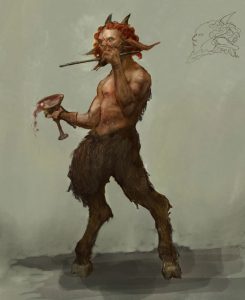In the Alters’ World (and the series of books found here), creatures of legend reveal themselves to the world. Born through genetic abnormalities, defects and mutations, the Alters have lived for centuries as outcasts of human society, hiding their true nature from the world while colorful stories have been written by many to describe what they’ve seen. How are these creatures different from what was described in the stories? What relationship do they have with humanity? Every entry of the Alterpedia will delve into a new creature from around the world. This week we cover:
Satyr-kin

Playing musical instruments often heard echoing on the winds, Satyr are wild men of the woods accompanying the god of wine, Dionysus. Together with the Faun, their Roman equivalent, these creatures take up one of the more benevolent demi-human roles in Greek and Roman mythology. Though changing somewhat in form over the years, the core of what it means to be a Satyr remains much the same. Known for their great love of excess, lack of personal control, and deep connection to nature, these goat-men represent the allure of more wild natures and the desire to be free of social expectations. Should you avoid the lure of such things, they would mean you little harm under most circumstances.
However, as time has gone on, the image of the Satyr has taken more demonic overtones. Dovetailed into the Judeo-Christian views of demons, Satyr-like features now tend to represent a pact with the devil. Their excess, once seen as a callback to simpler times, now represents to some a perversion and corruption of man. The call of the wild once seen as simply being a part of human nature is now a shameful, horrible act which Satyrs have come to be blamed for.
But just how interested are they in corrupting mankind and how much is just a fear of what lies within? Continue reading Alterpedia: Satyrs and Faun


